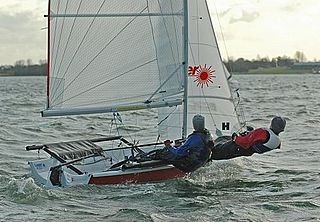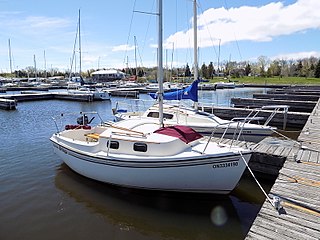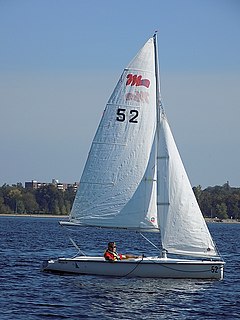First commercial fiberglass version
The Minto skiff eventually got stored in Bob's barn, where his friend Heine Dole, a NW marine architect, saw it and convinced Bob it would make a great dinghy reproduced in fiberglass. Heine took the skiff to Ed Hoppen, the Gig Harbor boat builder who was the original builder of the popular Thunderbird sailboats. After cutting out about two feet and reshaping the hull, Dole and Hoppen used the old Minto skiff as the plug for the first fiberglass Minto mold. Initially the objective was to only build five boats for themselves, Bob Schoen, and some friends. Hull number one was destroyed in trying to remove it from the mold, but hulls two through six did survive and are still in use today. As interest in the attractive little boats grew Hoppen was prompted by numerous requests to put the Minto into regular production. Ed Hoppen produced a couple hundred EDDON Boat Yard Mintos in the early 1960s, and then in the mid-1960s licensed Howard Smith, the owner of Ranger Boats in Kent, Washington, to add the Minto to his increasing line of small rowing and sailing craft. Until Ranger was sold in 1999, "Smitty" produced about 1000 Ranger Mintos, becoming one of the most popular and recognized yacht tenders in the NW.
Although the little steamship graphic displayed on the sails of the EDDON, Ranger and Rich Passage Boats Minto dinghies implies a direct link to the SS Minto steamship that operated on Arrow Lake in British Columbia for over 50 years, the association was created by Ed and Heine. They were looking for a way to make the new little fiberglass dinghy distinctive and they thought there was a similarity to the life boats used on the SS Minto and so chose the steamship graphic for the Minto.

Dinghy sailing is the activity of sailing small boats by using five essential controls:

Dinghy racing is a competitive sport using dinghies, which are small boats which may be rowboats, have an outboard motor, or be sailing dinghies. Dinghy racing has affected aspects of the modern sailing dinghy, including hull design, sail materials and sailplan, and techniques such as planing and trapezing.

The Thistle is an American planing sailing dinghy that was designed by Sandy Douglass as a one-design racer and first built in 1945.

The International 505 is a One-Design high-performance two-person monohull planing sailing dinghy, with spinnaker, utilising a trapeze for the crew.

The J/24 is an international One-Design trailerable keelboat class built by J/Boats and defined by World Sailing. The J/24 was created to fulfill the diverse needs of recreational sailors such as cruising, one design racing, day sailing, and handicap racing.
The Blue Jay is an American sailing dinghy that was designed by Drake Sparkman of Sparkman & Stephens as a trainer for the Lightning one-design racer. The Blue Jay was first built in 1947.

The Laser 4000 is a racing dinghy designed by Phil Morrison crewed by two persons. Its one-design weight-equalised system enables physically differing sailors to compete on a level playing field. It is most popular in Europe, particularly the UK, France and Italy.

The Jet 14 is an American sailing dinghy that was designed by Howard Siddons as a one-design racer and first built in 1952.

Model yachting is the pastime of building and racing model yachts. It has always been customary for ship-builders to make a miniature model of the vessel under construction, which is in every respect a copy of the original on a small scale, whether steamship or sailing ship. There are fine collections to be seen at both general interest museums such as the Victoria and Albert Museum in London and at many specialized maritime museums worldwide. Many of these models are of exquisite workmanship, every rope, pulley or portion of the engine being faithfully reproduced. In the case of sailing yachts, these models were often pitted against each other on small bodies of water, and hence arose the modern pastime. It was soon seen that elaborate fittings and complicated rigging were a detriment to rapid handling, and that, on account of the comparatively stronger winds in which models were sailed, they needed a greater draught. For these reasons modern model yachts, which usually have fin keels, are of about 15% or 20% deeper draught than full-sized vessels, while rigging and fittings have been reduced to absolute simplicity. This applies to models built for racing and not to elaborate copies of steamers and ships, made only for show or for " toy cruising."

The Lido 14 is an American sailing dinghy that was designed by Barney Lehman and W.D. Schock and first built in 1958.
The Rhodes 19 is an American trailerable day sailer or sailing dinghy, that was designed by Philip Rhodes as a one-design racer and first built in 1958.

The Sanibel 18 is an American trailerable sailboat, that was designed by Charles Ludwig, first built in 1982 and named for the Floridian town and island.

The Martin 16 is a Canadian trailerable sailboat, that was designed by Don Martin of Vancouver, British Columbia, specifically as a boat for disabled sailors. It was first built in 1995.

The Douglas 31 and Douglas 32 are a series of Canadian sailboats, that were designed by Ted Brewer and first built in 1967. The last boats of this design were built in 1982 and delivered as kits.
The Geary 18 is an American sailboat that was designed by Ted Geary as a one-design racer and first built in 1926.
The Interclub Dinghy is an American sailing dinghy that was designed by Sparkman & Stephens as a one-design racer and first built in 1946. It is sailed in frostbite racing on the US east coast, particularly on Long Island Sound. Frostbite races are the series held after the normal sailing season is finished.
The Puffer is an American rowboat, motorboat and sailing dinghy that was designed by Fred Scott and first built in 1972.
The Tech Dinghy is an American sailing dinghy that was designed by George Owen, a professor at Massachusetts Institute of Technology (MIT), as a one-design racer and for sail training. It was first built in 1935.
The Bay Hen 21 is an American trailerable sailboat that was designed by Reuben Trane as a pocket cruiser and first built in 1984.
The Mobjack is an American sailboat that was designed by Roger Moorman as a one design racer and first built in 1956.
This page is based on this
Wikipedia article Text is available under the
CC BY-SA 4.0 license; additional terms may apply.
Images, videos and audio are available under their respective licenses.












